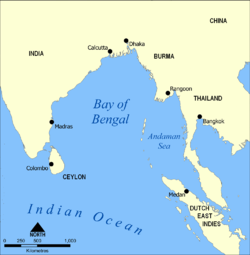Action of 31 May 1809
| Action of 31 May 1809 | |||||||
|---|---|---|---|---|---|---|---|
| Part of the Napoleonic Wars | |||||||
|
Location of the Action of 31 May 1809 |
|||||||
|
|||||||
| Belligerents | |||||||
|
|
|
||||||
| Commanders and leaders | |||||||
| Jean-Baptiste-Henri Féretier | John Dale | ||||||
| Strength | |||||||
| frigate Caroline | East Indiamen Streatham, Europe and Lord Keith | ||||||
| Casualties and losses | |||||||
| 1 killed, 4 wounded | 6 killed, 4 wounded, Streatham and Europe captured | ||||||
Coordinates: 9°15′N 90°30′E / 9.250°N 90.500°E
The Action of 31 May 1809 was a naval skirmish in the Bay of Bengal during the Napoleonic Wars. During the action, an Honourable East India Company convoy carrying goods worth over £500,000 was attacked and partially captured by the French frigate Caroline. The three East Indiamen that made up the convoy fought against their opponent with their own batteries of cannon but ultimately were less powerful, less manoeuvrable and less trained than their opponent and were defeated one by one; only the smallest of the three escaped. The action was the first in a string of attacks on important convoys in the Indian Ocean by French cruisers operating from Île de France and Île Bonaparte during a concerted campaign against British shipping in the region.
In November 1808, a squadron of powerful French frigates sailed for Île de France under Commodore Jacques Hamelin. This squadron was under orders to attack and capture or destroy British shipping in the Indian Ocean, particularly the heavily armed convoys of East Indiamen that carried millions of pounds worth of trade goods from British India and the Far East to Britain. These convoys were operated by the Honourable East India Company (HEIC), which ran British India and maintained a private army and navy to secure the colony and its trade routes. During the late Napoleonic Wars, French naval strategy focused on the disruption of this trade with the use of fast and well-armed frigates to operate independently along British trade routes and capture British merchant ships. This affected the British economy, which was already severely stretched by the war, and forced the Royal Navy to divert resources to distant parts of the world to protect British trade.
...
Wikipedia

